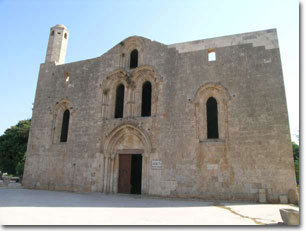|
 220 km
north west of Damascus - about 60 km south of Lattakia; Tartous has
been rapidly developed in recent decades as Syria's second port city,
with a number of major industries to the north. It has been connected
to the national rail and road grid and the expansion of the city has
robbed it of much of its sleepy charm as a small Mediterranean fishing
port with its roots firmly planted in the past. The old city retains
some of its character and the former Cathedral of Our Lady of Tortosa
is one of the most remarkable surviving remains of the religious
architecture of the Crusaders outside Jerusalem. 220 km
north west of Damascus - about 60 km south of Lattakia; Tartous has
been rapidly developed in recent decades as Syria's second port city,
with a number of major industries to the north. It has been connected
to the national rail and road grid and the expansion of the city has
robbed it of much of its sleepy charm as a small Mediterranean fishing
port with its roots firmly planted in the past. The old city retains
some of its character and the former Cathedral of Our Lady of Tortosa
is one of the most remarkable surviving remains of the religious
architecture of the Crusaders outside Jerusalem.
Tartous was originally founded by Phoenicians to complement the more
secure but less accessible settlement on the island of Arwad. It was
also an important, though secondary after Arwad, center in Seleucid and
Roman times. The classical name, Antaradus (anti-Aradus - "the town
facing Aradus" or Arwad) reflected this secondary role. Constantine
(306 - 337) made it a separate city and his successor, Constantius
renamed it "Constantia" in 346 as he favored its Christian inhabitants
over the pagans of Arwad. One of the earliest chapels in the Virgins
honor was built there before the 4th century. The altar of the chapel
is believed to have miraculously escaped destruction by an earthquake
in 487. An icon said to have been painted by the evangelist St Luke,
was also venerated there. 
After passing into Muslim hands with the Arab conquest in the 630s,
Tartous was one of the towns the Byzantine Emperor Nicephorus II Phocas
retook in his effort to reassert Byzantine sovereignty in Syria in 968.
Once again it fell to the Arabs hands, but in 1101, Raymond de Saint
Gilles, Count of Toulouse began his concerted campaign to take Tripoli
and the areas connecting the coast and the Orontes near Homs. He turned
Tartous into a fortress city owing allegiance to Tripoli. The Franks
strongly promoted the Marian pilgrimage and after 1123 began
construction of the cathedral of Our Lady of Tortosa. The city was
occupied by Nūr al din in 1152 then his nephew, Saladin, added Tartous
to his victories in 1188. The Cathedral of Our Lady Dates entirely from the 13th century improvements to the original Crusader redevelopments. It had
lost most of the two towers it had. The plan is three aisled basilicas,
each has four bays and ends in an apse, the central one being preceded
by a short choir. The eastern towers are still reachable by the
passageways off the apses. 
The Museum It contains a number of objects of interest from various periods,
notably: Syro/Phoenician finds; some figures from 5th century Greek
colonization; Roman glass; bronze and sculptures; as well as later
remains. The Fortress The
concentric defenses consisted of: outer ditch and town wall; inner
ditch and first defense wall around the citadel; main citadel wall in
with square bastions; and the central donjon. |